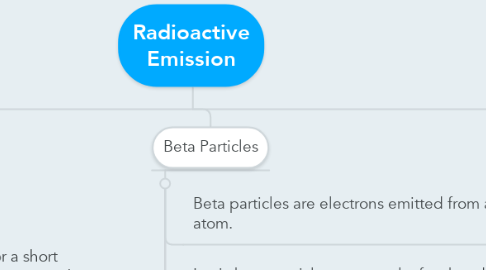Radioactive Emission
by Akim PJ

1. Alpha Particles
1.1. Alpha particles are a type of radiation that do not travel very far.
1.2. Alpha particles are effective only for a short distance because they use up their energy when they hit other atoms.
1.2.1. Alpha particles are effective only for a short distance because they use up their energy when they hit other atoms.
1.3. Alpha particles do not pass through anything very thick.
1.4. Alpha particlescan generally be absorbed or stopped by an inch or less (1-2 centimeters) of air or a thin piece of tissue.
2. Beta Particles
2.1. Beta particles are electrons emitted from an atom.
2.2. In air, beta particles can travel a few hundred times farther than alpha particles—up to six feet (two meters) or more for the beta particles with higher energies.
2.3. For the common low-energy beta emitters used in laboratories, light clothing or a few centimeters of air can stop the beta radiation.
2.4. For higher energy beta emitters, a centimeter or two of plastic will stop most of the particles.
3. Gamma Rays
3.1. Gamma rays (also called photons) are waves of energy that travel at the speed of light.
3.2. These waves can have considerable range in air and have greater penetrating power (can travel farther) than either alpha or beta particles.
3.3. Gamma rays come from the nucleus of an atom.


